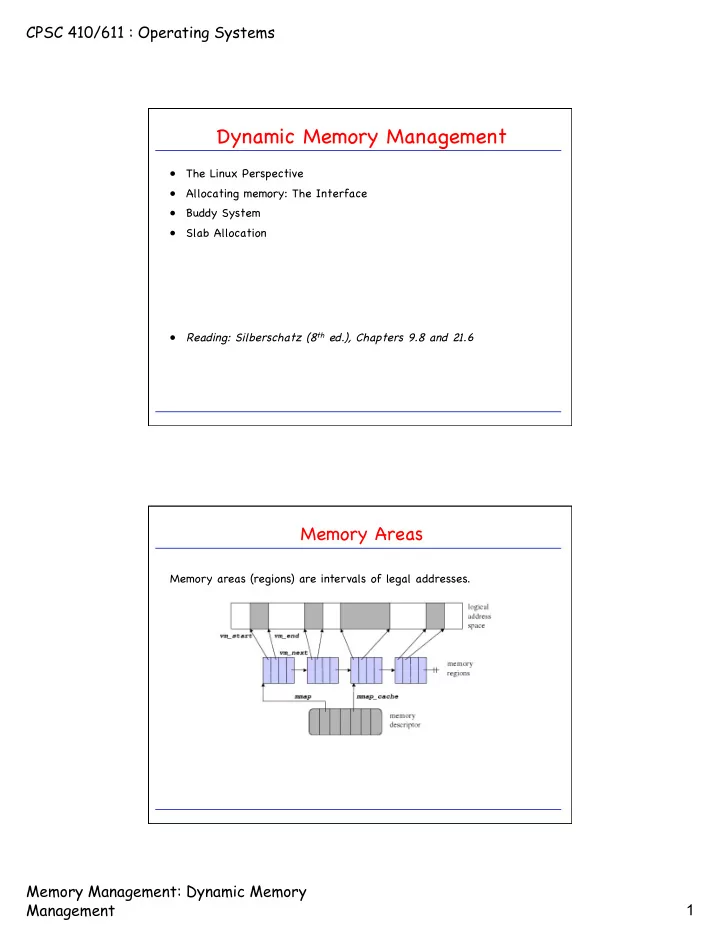

CPSC 410/611 : Operating Systems Dynamic Memory Management � • � The Linux Perspective � • � Allocating memory: The Interface � • � Buddy System � • � Slab Allocation � • � Reading: Silberschatz (8 th ed.), Chapters 9.8 and 21.6 � Memory Areas � Memory areas (regions) are intervals of legal addresses. � Memory Management: Dynamic Memory Management 1
CPSC 410/611 : Operating Systems The Process Address Space � • � When does new memory get allocated? � – � Process stack grows � – � Process “creates” (attaches) to shared memory segment ( shmat() ) � – � Process expands heap ( malloc() ) � – � New process gets created ( fork() ) � – � New program gets loaded into memory ( execve() ) � – � Map a file to memory ( mmap() ) � • � Create new address interval: � – � Kernel uses do_mmap() call. � – � Available through system call mmap() in user space. � Allocating Pages � • � Requesting frames: � struct page * alloc_pages(uint gfp_mask, uint order) • � Requesting pages (logical addresses): � ulong __get_free_pages(uint gfp_mask, uint order) • � In both cases: � – � request allocates 2 order pages/frames � – � gfp_mask specifies details about request: � • � memory zone � • � behavior of allocator (blocking/unblocking request, etc.) � • � e.g. GFP_KERNEL , GFP_ATOMIC , GFP_DMA , etc. � Memory Management: Dynamic Memory Management 2
CPSC 410/611 : Operating Systems Allocation at Different Levels � • � alloc_pages() and __get_free_pages() – � allocate pages, at low level � – � useful to allocate contiguous pages/frames. � • � byte-sized allocations: � – � kmalloc(size, gfp_mask) • � allocate physically contiguous sequence � of bytes � – � vmalloc(size, gfp_mask) • � allocate virtually contiguous sequence � of bytes � • � explicit user-level allocation: � – � malloc(size) • � allocate virtually contiguous sequence of bytes at user level � How does this all work? � • � alloc_pages() and __get_free_pages() – � allocate pages, at low level � Buddy Sys Bu y System! em! � – � useful to allocate contiguous pages/frames. � • � byte-sized allocations: � – � kmalloc(size, gfp_mask) • � allocate physically contiguous sequence � Sl Slab b Allocator � of bytes � (+ cachin (+ c ing) � – � vmalloc(size, gfp_mask) • � allocate virtually contiguous sequence � of bytes � • � explicit user-level allocation: � – � malloc(size) • � allocate virtually contiguous sequence of bytes at user level � Memory Management: Dynamic Memory Management 3
CPSC 410/611 : Operating Systems Naïve Allocation in Action � 64k � 64k � 64k � 64k � 64k � 64k � 64k � 64k � 64k � 64k � 64k � 64k � 64k � 64k � 64k � 64k � free list � 1024k � Buddy System Allocation � • � Allocation: � – � Increase size of request to next power of 2*. � – � Look up block in free lists. � – � If exists, allocate. � – � If none exists, split next larger block in half, put first half (the “buddy”) on free list, and return second half. � • � De-Allocation: � Harry Markowitz � – � Return segment to free list. � 1927- � 1990 Nobel Memorial � – � Check if buddy is free. If so, coalesce. � Prize in Economics � • � For details, see lecture. � (*) For case of binary buddy system. � References: Donald Knuth: The Art of Computer Programming Volume 1: Fundamental Algorithms. Second Edition (Reading, Massachusetts: Addison-Wesley, 1997), pp. 435-455. ISBN 0-201-89683-4 � Memory Management: Dynamic Memory Management 4
CPSC 410/611 : Operating Systems Buddy System in Action � free lists � 64k � 64k � 64k � 64k � 64k � 64k � 64k � 64k � 64k � 64k � 64k � 64k � 64k � 64k � 64k � 64k � 1024k � 1024k � 512k � 512k � 512k � 256k � 256k � 256k � 256k � 256k � 128k � 128k � 128k � 128k � 128k � 64k � 64k � 64k � 37k? � 37k? 64k � 67k? 128k � 7k? � 11 112k? 128k � 2k? � 150k? � 150k? 256k � Slab Allocation � • � First described by Jeff Bonwick for the SunOS kernel. � • � Currently used in Linux and other kernels. � • � Key observations: � – � Kernel memory often used for allocated for a finite set of objects, such as file descriptors and other common structures. � – � Amount of time required to initialize a regular object in the kernel exceedes the amount of time required to allocate and de-allocate it. � • � Conclusion: � – � Instead of freeing the memory back to a global pool, have the memory remain initialized for its intended purpose. � • � References: "The Slab Allocator: An Object-Caching Kernel Memory Allocator (1994)” � Memory Management: Dynamic Memory Management 5
CPSC 410/611 : Operating Systems Slab Allocation (II) � • � Set of objects pre-allocated � • � Marked as free � • � When needed, assign a free one and mark as used � • � No free ones available? � – � allocate a new slab � – � slab states (full, empty, partial) � – � fill partial slab first � • � Advantages: � – � no fragmentation � – � memory requests � satisfied quickly � Memory Management: Dynamic Memory Management 6
Recommend
More recommend